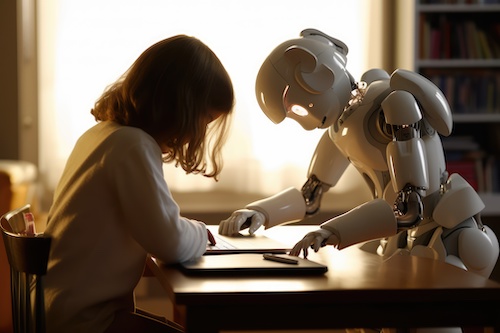[ad_1]
Key factors:
By now, we hear the time period “synthetic intelligence” quite a lot of instances a day. However regardless of the stereotypical sci-fi depictions of AI, it has a professional place in at present’s school rooms.
Revolutionary educators and college students are discovering new methods to combine AI into educating and studying day by day. Lecturers can spend extra one-on-one time with college students after they use AI to shortly full tedious duties. College students, alternatively, discover ways to critically consider info and find out about biases after they analyze info coming from generative AI sources.
Listed below are 5 methods educators are incorporating AI into the lecture rooms proper now:
1. This English instructor created a project-based situation: The scholars have been attorneys for a legislation agency, and the instructor is their shopper, bringing them this problem: She is considering investing in ChatGPT. Primarily based on their understanding and the analysis they’d conduct throughout The Crucible unit, ought to she? What could be the implications? The upsides and the down? Sometimes, on the finish of a unit on The Crucible, she asks college students to place numerous characters on trial, backing up their concepts with loads of unique proof. This time round, she needed them to additionally put ChatGPT on trial. What are its strengths and alternatives, its weaknesses and threats?
2. These Florida-based lecturers are utilizing AI to prioritize student-centered actions: Each scholar wants one thing barely completely different to be taught effectively. When we’ve instruments as lecturers that permit us to fulfill these individualized wants and help the entire scholar, we all know that studying improves. We will now use AI to customise actions that help psychological well being, give college students extra possession over their very own studying, and even present extra individualized, responsive tutoring. Your college students will doubtless see AI exhibiting up of their school rooms this yr in ways in which put them within the driving seat and assist make studying really feel directed exactly at them, their wants, and their pursuits.
3. This educator posits that ChatGPT is now part of studying, and lecturers should settle for it–with a couple of situations: It’s time for educators to deal with ChatGPT as an unreliable accomplice in all assignments and to offer a method for college kids to tell us how a lot assist they acquired. He specifies an unreliable accomplice as a result of there is no such thing as a solution to know the place ChatGPT received its info for any single response. It makes use of a mathematical mannequin of doubtless phrases, not analysis. It’s mainly auto-complete on steroids. ChatGPT is sort of a classmate who has learn extensively and is de facto assured about every little thing they are saying however can’t bear in mind precisely the place they received their info from. It could possibly be a tutorial publication or it could possibly be a conspiracy web site. And that’s how we should always deal with it – a accomplice who sounds like they know what they’re speaking about however nonetheless must be fact-checked.
4. A better-ed college member provides insights on the way to decide if generative AI has been utilized in assignments: Instructors in any respect ranges ought to contemplate sure standards to assist them decide whether or not text-based submissions have been scholar or AI-generated. Lack of non-public experiences or generalized examples are a possible signal of AI-generated writing–for example, “My household went to the seashore within the automotive” is extra more likely to be AI-generated than “Mother, Betty, and Rose went to the threerd Avenue seashore to swim.” Instructors ought to search for uncommon or full phrases {that a} scholar wouldn’t usually make use of–a highschool scholar talking of a lacuna in his college information may be an indication the paper was AI-generated.
5. This college chief makes use of AI to assist college students be taught historical past by having life-like conversations with tech-powered variations of Socrates, Gandhi, and Dr. Martin Luther King. College students can find out about gravity by chatting with an AI-powered model of Sir Isaac Newton. They will find out about artwork from Frida Kahlo and about WW2 by chatting with a teenage model of Anne Frank. This stage of engagement was remarkable prior to now.
[ad_2]
